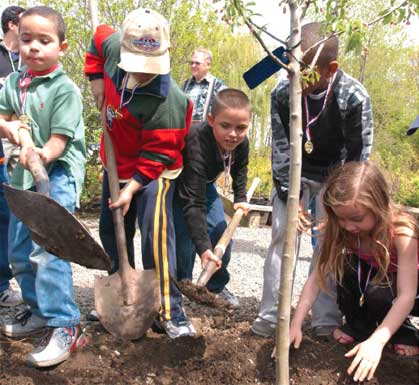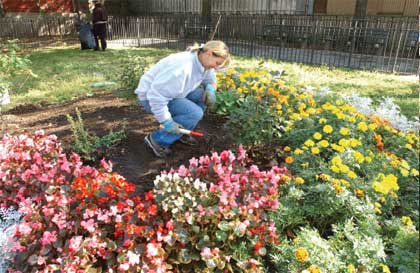Parks & Recreation 2002-2003 Biennial Report
Eight Seasons of Progress
Greening New York

Today I have grown taller from walking with the trees.
-Karle Wilson Baker “Good Company,” 1922
- At 134 feet tall, New York City’s tallest tree is a tuliptree in Alley Pond Park, Queens.
- Parks & Recreation recycled 25,719 holiday trees through MulchFest 2003.
- Operation Releaf has received substantial support from the private sector. The American Museum of Natural History contributed $70,000 for the greening of Theodore Roosevelt Park, and the Carl Schurz Park Association underwrote the refurbishment of Carl Schurz Park with $43,000.
NOTHING DEFINES A CITY PARK MORE than soaring trees, open lawns, and blooming gardens. Yet, plants are more than just graceful to the eye. Both common sense and scientific study have shown that greenery in the center of busy traffic, gardens amidst concrete sidewalks, and urban forests all have a calming, even restorative, effect on the city dweller.
Recognizing this, Parks & Recreation has renewed its commitment to the science and art of horticulture. In order to better care for our gardens, all 3,000 year-round employees attended horticulture training. Well over 2 million flowers and more than 15,000 new street trees were planted. And, in a legal settlement negotiated by the Bloomberg administration, we acquired 198 new community gardens, bringing the total number of community gardens protected as parkland to 300. With the support of our GreenThumb division, volunteers maintain all of our community gardens.
To encourage volunteer interest and usher new ideas into the agency, we created the “Uncommon Ground” lecture series, inviting renowned landscape architects to share their visions. One lecturer, Piet Oudolf, created a signature garden in the Battery with the support of the Battery Conservancy and a $1 million grant from Verizon.
OPERATION RELEAF
Through a new initiative called Operation Releaf, we restored 117 degraded landscapes in parks and playgrounds with trees, shrubs, and flowers, often using plants grown in our two nurseries and three greenhouses. In 2003, we expanded this program to include “Greeting Gardens,” small, decorative planting beds at park entrances with historical and directional signage that welcomes and orients visitors. In our first season, we planted 30 greeting gardens across the city.
Through the successful Greenstreets program, we converted 51 barren traffic triangles and roadway medians into pocket parks and tree-lined malls. Local citizens and corporations, including MetLife and Wendy’s, adopted many greenstreets, which now number more than 2,050.

THE CRABAPPLE TREE
More than 60 years ago, the spreading, low-branched crabapple tree was a favorite among New York City landscape architects. This multi-stemmed crabapple slater fell out of fashion, and old specimens began to die out. We are bringing the sweet-smelling crabapple tree back to New York City. This past season, we planted 100 crabapples, and we will soon begin propagating “heritage” cultivars in our own nurseries.
LOOKING AHEAD
We will expand our Greenstreet, Greeting Garden, and Operation Releaf programs with the planting of more trees, shrubs, and flowers in all of our landscape designs. We will continue to work closely with our federal and state partners to eradicate the Asian longhorned beetle, an invasive pest that has destroyed more than 3,800 trees since first discovered in New York City in 1996. With the New York Tree Trust and Trees New York, we will help residents care for their neighborhood trees and greenstreets. And, we will develop and pilot new strategies to improve the health of trees, focusing on soil mix, bare-root plantings, and tree-sidewalk conflicts.
Trees comprise the living component of our city’s infrastructure. They are as vital as roads, electricity, and running water; they give breath to our city. Everyone needs to take responsibility for their care.
-Barbara Eber-Schmidt
Executive Director, Trees New York
